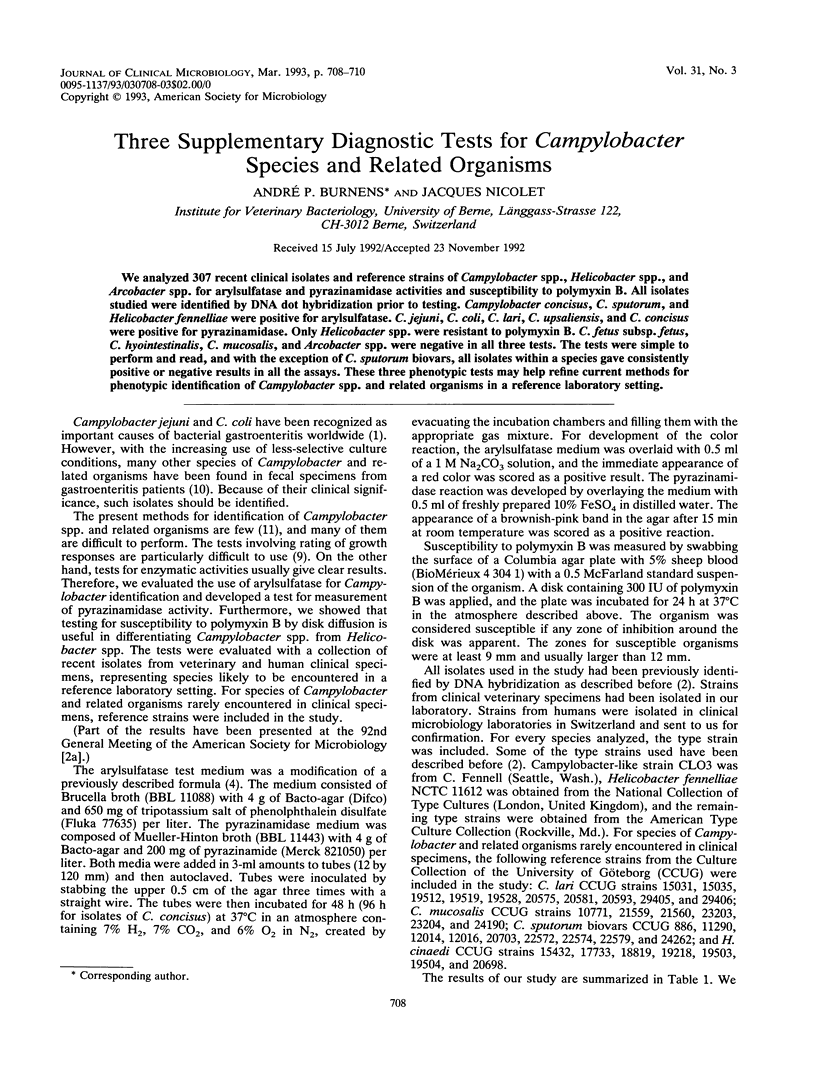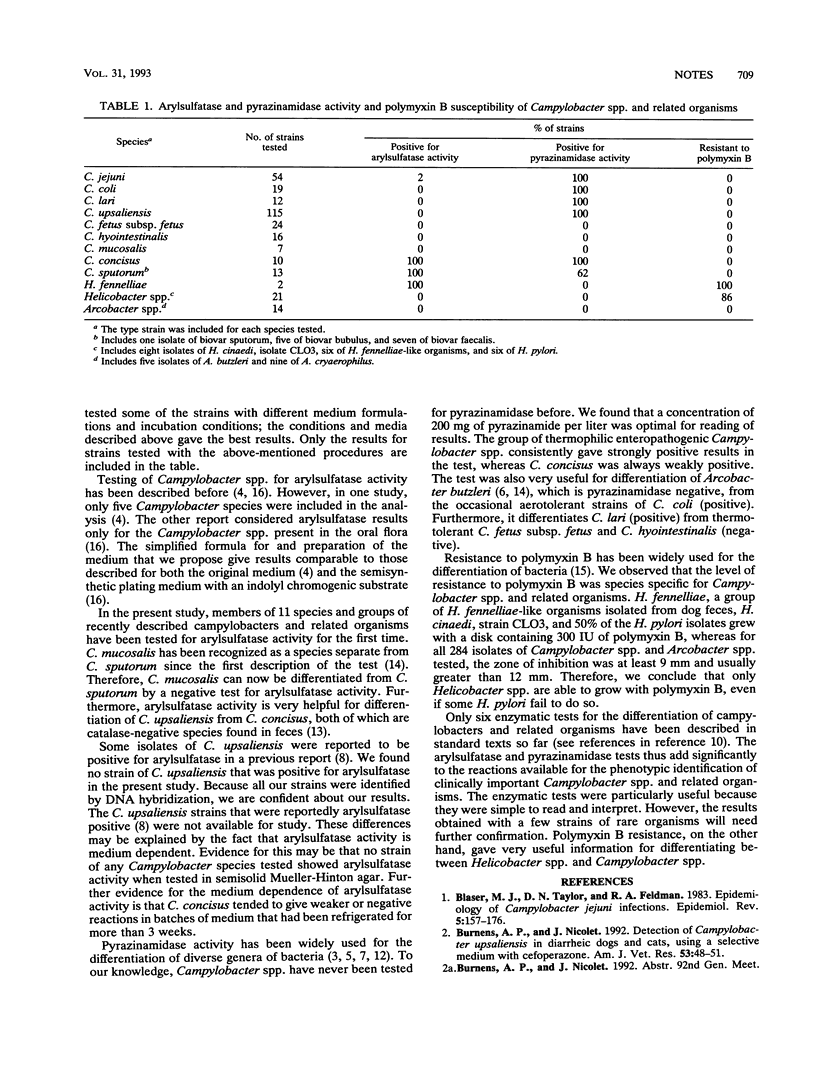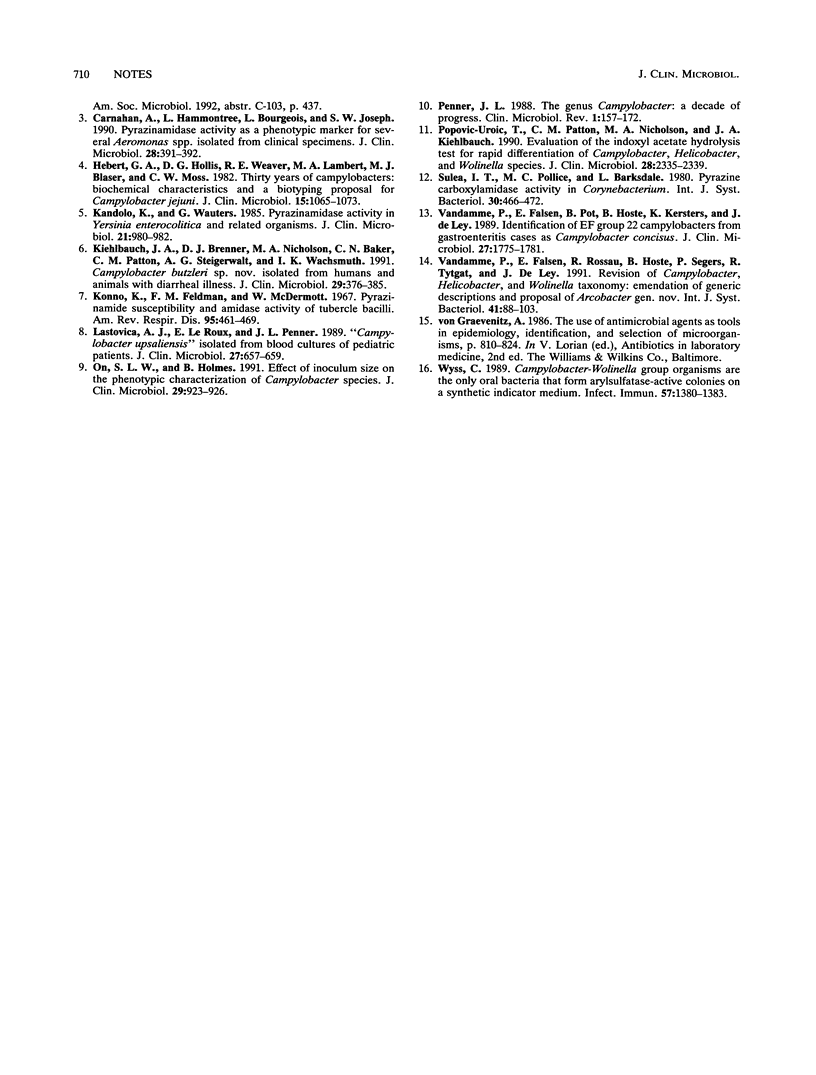Abstract
We analyzed 307 recent clinical isolates and reference strains of Campylobacter spp., Helicobacter spp., and Arcobacter spp. for arylsulfatase and pyrazinamidase activities and susceptibility to polymyxin B. All isolates studied were identified by DNA dot hybridization prior to testing. Campylobacter concisus, C. sputorum, and Helicobacter fennelliae were positive for arylsulfatase. C. jejuni, C. coli, C. lari, C. upsaliensis, and C. concisus were positive for pyrazinamidase. Only Helicobacter spp. were resistant to polymyxin B. C. fetus subsp. fetus, C. hyointestinalis, C. mucosalis, and Arcobacter spp. were negative in all three tests. The tests were simple to perform and read, and with the exception of C. sputorum biovars, all isolates within a species gave consistently positive or negative results in all the assays. These three phenotypic tests may help refine current methods for phenotypic identification of Campylobacter spp. and related organisms in a reference laboratory setting.
Full text
PDF


Selected References
These references are in PubMed. This may not be the complete list of references from this article.
- Blaser M. J., Taylor D. N., Feldman R. A. Epidemiology of Campylobacter jejuni infections. Epidemiol Rev. 1983;5:157–176. doi: 10.1093/oxfordjournals.epirev.a036256. [DOI] [PubMed] [Google Scholar]
- Burnens A. P., Nicolet J. Detection of Campylobacter upsaliensis in diarrheic dogs and cats, using a selective medium with cefoperazone. Am J Vet Res. 1992 Jan;53(1):48–51. [PubMed] [Google Scholar]
- Carnahan A., Hammontree L., Bourgeois L., Joseph S. W. Pyrazinamidase activity as a phenotypic marker for several Aeromonas spp. isolated from clinical specimens. J Clin Microbiol. 1990 Feb;28(2):391–392. doi: 10.1128/jcm.28.2.391-392.1990. [DOI] [PMC free article] [PubMed] [Google Scholar]
- Hébert G. A., Hollis D. G., Weaver R. E., Lambert M. A., Blaser M. J., Moss C. W. 30 years of campylobacters: biochemical characteristics and a biotyping proposal for Campylobacter jejuni. J Clin Microbiol. 1982 Jun;15(6):1065–1073. doi: 10.1128/jcm.15.6.1065-1073.1982. [DOI] [PMC free article] [PubMed] [Google Scholar]
- Kandolo K., Wauters G. Pyrazinamidase activity in Yersinia enterocolitica and related organisms. J Clin Microbiol. 1985 Jun;21(6):980–982. doi: 10.1128/jcm.21.6.980-982.1985. [DOI] [PMC free article] [PubMed] [Google Scholar]
- Kiehlbauch J. A., Brenner D. J., Nicholson M. A., Baker C. N., Patton C. M., Steigerwalt A. G., Wachsmuth I. K. Campylobacter butzleri sp. nov. isolated from humans and animals with diarrheal illness. J Clin Microbiol. 1991 Feb;29(2):376–385. doi: 10.1128/jcm.29.2.376-385.1991. [DOI] [PMC free article] [PubMed] [Google Scholar]
- Konno K., Feldmann F. M., McDermott W. Pyrazinamide susceptibility and amidase activity of tubercle bacilli. Am Rev Respir Dis. 1967 Mar;95(3):461–469. doi: 10.1164/arrd.1967.95.3.461. [DOI] [PubMed] [Google Scholar]
- Lastovica A. J., Le Roux E., Penner J. L. "Campylobacter upsaliensis" isolated from blood cultures of pediatric patients. J Clin Microbiol. 1989 Apr;27(4):657–659. doi: 10.1128/jcm.27.4.657-659.1989. [DOI] [PMC free article] [PubMed] [Google Scholar]
- On S. L., Holmes B. Effect of inoculum size on the phenotypic characterization of Campylobacter species. J Clin Microbiol. 1991 May;29(5):923–926. doi: 10.1128/jcm.29.5.923-926.1991. [DOI] [PMC free article] [PubMed] [Google Scholar]
- Penner J. L. The genus Campylobacter: a decade of progress. Clin Microbiol Rev. 1988 Apr;1(2):157–172. doi: 10.1128/cmr.1.2.157. [DOI] [PMC free article] [PubMed] [Google Scholar]
- Popovic-Uroic T., Patton C. M., Nicholson M. A., Kiehlbauch J. A. Evaluation of the indoxyl acetate hydrolysis test for rapid differentiation of Campylobacter, Helicobacter, and Wolinella species. J Clin Microbiol. 1990 Oct;28(10):2335–2339. doi: 10.1128/jcm.28.10.2335-2339.1990. [DOI] [PMC free article] [PubMed] [Google Scholar]
- Vandamme P., Falsen E., Pot B., Hoste B., Kersters K., De Ley J. Identification of EF group 22 campylobacters from gastroenteritis cases as Campylobacter concisus. J Clin Microbiol. 1989 Aug;27(8):1775–1781. doi: 10.1128/jcm.27.8.1775-1781.1989. [DOI] [PMC free article] [PubMed] [Google Scholar]
- Vandamme P., Falsen E., Rossau R., Hoste B., Segers P., Tytgat R., De Ley J. Revision of Campylobacter, Helicobacter, and Wolinella taxonomy: emendation of generic descriptions and proposal of Arcobacter gen. nov. Int J Syst Bacteriol. 1991 Jan;41(1):88–103. doi: 10.1099/00207713-41-1-88. [DOI] [PubMed] [Google Scholar]
- Wyss C. Campylobacter-Wolinella group organisms are the only oral bacteria that form arylsulfatase-active colonies on a synthetic indicator medium. Infect Immun. 1989 May;57(5):1380–1383. doi: 10.1128/iai.57.5.1380-1383.1989. [DOI] [PMC free article] [PubMed] [Google Scholar]


